The Absheron Peninsula is located in the east of the Republic of Azerbaijan, the south-eastern end of the Greater Caucasus, and on the west coast of the Caspian Sea (Fig. 1). The peninsula is the most economically and socially developed region in the country. The majority of chemistry, petrochemical and oil refinery facilities are concentrated here. About 80 % of oil and gas production, and 1/3 part of the electricity generated in the country is accounted by this peninsula where the State Region Power Stations of “Shimal” and “Ahmadli” as well as four power stations more are located.
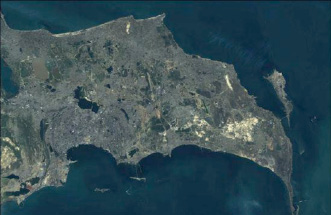
Fig. 1. Absheron Peninsula
The development of the oil industry on the Absheron Peninsula had a positive impact on resettlement of population. Development of the oil industry at early twentieth century led to the elevation of level of productive forces followed by the high flow of workforce to the city of Baku. Rapid development of oil-producing areas around the city led to the origination of new residential areas near the settlements of Sabunchu, Balakhani, Ramana, Zabrat, Surakhani, Binagadi and Bibiheybat. Later, the rapid development of urbanization and urban planning entailed the establishment of the city of Sumgait and 20 new settlements, as well as transformation of 40 villages into urban settlements. Presently, presence of Baku city, and also the cities of Sumgait and Khirdalan has a positive impact on the economic development of the region. However, the mentioned factors have been responsible for arising of number of environmental problems in the region.
Materials and research methods
The ecological condition of polluted areas was assessed as a result of monitoring conducted in the study areas related to the exploitation of oil fields on the Absheron Peninsula.
Based on the published literature, the depths and percentage ratios of oil-contaminated layers were determined.
Toxic trace elements were identified in the composition of oil-contaminated rocks. Some radiometric measurements data were also used for the study.
Research results and discussion
The main environmental problems experienced by Azerbaijan in modern times have been related to the long-term oil and gas production led on the Absheron peninsula (Fig. 2), the Caspian Sea and the coastal areas to meet the energy needs of the former Soviet Union without considering the ecological requirements and consequences. Relatedly, the main causes of environmental problems in the area were: contamination of soil with wastes of oil extraction; origination of artificial lakes and ponds polluted with oil due to the lack of wastewater management for many years; and concentration of wastes of oil refining facilities.
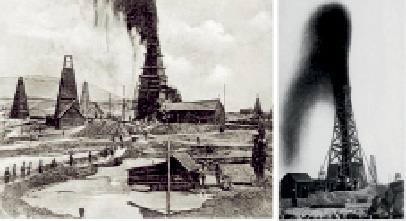
Fig. 2. Oilfields on the Absheron Peninsula (Until 1920)
Absheron’s oil industry makes its contribution to the development of the world economy. The oil of Absheron contains lower portion of sulfur, paraffin, resin and cox, and this factor indicates to higher quality of oil, and makes the refinery process cheaper as well. 39 million tons of oil has been produced in the country in 2017, according to official data.
In general, the ecological condition on the Absheron Peninsula has been deteriorated (Fig. 3) during the period of more than 150 years as a result of the development of oil industry. Recent studies confirm that the total area of oil-polluted areas is 10.6 thousand ha, while all the areas contaminated due to human activity make up 33 thousand ha.
“Complex Action Plan for 2006-2010 on Improvement of Ecological Situation in the Republic of Azerbaijan” was approved with the Decree of the President of the Republic of Azerbaijan dated to September 28, 2006 in order to improve the environmental situation. Under the Complex Action Plan it is envisaged to undertake appropriate measures as part of the works on the reconstruction of outdated communication facilities and establish new infrastructure [2]. Meantime, taking into consideration the limited financial resources, the Azerbaijani government prefers the step by step restoration of the infrastructure of the region and tends to assign the state budget and also resources of State Oil Fund to important projects on socio-economic development such as extension of communication networks, reconstruction and increase of capacity of the power generation facilities.
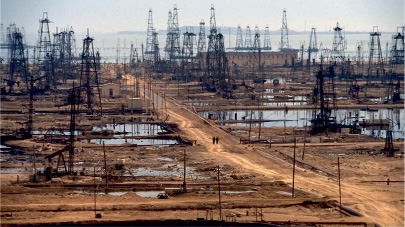
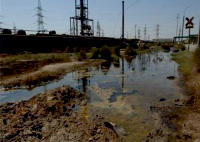
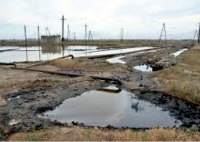
Fig. 3. Environmental problems associated with the oil industry
Extremely high levels of chemicals present due to oil contamination have a negative impact on vegetation, and may cause various diseases among population. Microelements that are soaked in soils have physiological and biochemical effect after penetrating a human body. Eventually, pathological diseases can occur. This is because vital functions of the organisms are influenced by the environment that may contain rich or poor amount of macro- and microelements in a specific area.
Experts estimate that the depth of the layer, contaminated by oil and oil products on the Absheron Peninsula, reaches 2,0-2,5 m. The content of oil products in the soil is up to 26 % [7]. Moreover, it should be noted that soils are dedegreed not only because of oil and oil products. The soils are subject to technogenic impact associated with socioeconomic activities that are typical for the entire area of the peninsula.
As is known, the degree of contamination with oil and oil products can be moderate (when the humus layer contains less than 6 % of oil) or heavy (when the humus layer contains more than 6 % of oil). Moderate contamination can be eliminated by activating the self-regulation process through using aerotechnical methods, whereas heavy pollution is preventable through using special measures that activate hydrocarbon processes
While the lakes of the Absheron Peninsula make up only 0.5 % of the country’s territory, the total volume of water collected in these lakes equal 40 km3. These lakes are subject to high pollution by both organic and chemical wastes, in particular oil and oil products. In Absheron, wastewaters discharged from refineries as well as oil and gas production facilities have generated ponds with area of 7-8 thousand ha in total. [6]. These lakes are responsible for such adverse processes as degradation and salinization of the soils, flooding of surrounding lands due to rise of water level, and also release of hydrocarbons and other harmful substances into the atmosphere as a result of evaporation. To eliminate this situation, most of the marshy areas and wastewater ponds in the coastal areas of Bilgah, Buzovna, Mardakan, Pirshaghi, Nardaran, Novkhani and Sumgait have been dried in accordance with the “National Strategy and Action Plan for the Conservation and Sustainable Use of Biodiversity in the Republic of Azerbaijan”, and the ecological balance has been restored [1].
Pollutants present in the composition of lands of Absheron are filtered to as far as almost the groundwater table. Since in some cases the degree of contamination is higher than the soil buffer properties, hydrocarbon compounds may penetrate into groundwater [4]. Ground waters on the peninsula are mineralized to varying degrees depending on the chemical composition of the rocks, the depth of the rocks, the relief and the distance from the sea.
The normal background radiation typical for the oilfield waters of the Absheron Peninsula makes up 9 μ/hour in the Caspian Sea and 18 μ/hour in the areas of tectonic infraction. However, some contaminated areas with background radiation at 500-600 μ/hour is recorded close to oil producing fields in the peninsula [6]. Oil production results in not only the contamination of fertile soils with oily pollutants and oilfield waters, but also the mechanical disturbances, destructions and degradation of the lands. Eventually, the areas of oilfields are not contaminated in the form of massifs but in the form of spots of different dimension. Technogenic complexity on the soil cover occurs as well [3]. Dissemination of such contamination should be prevented through the implementation of reclamation measures in those areas.
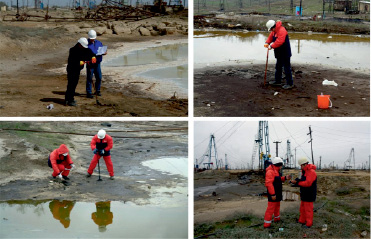
Fig. 4. Studies conducted to improve the ecological situation of the Absheron peninsula
To assess the ecological situation on the Absheron Peninsula relevant to contamination with oil and oil products, identifying the degree of degradation of the natural environment is needed. In this research we used the data of environmental monitoring carried out with respect to soils, contaminated with oil and oil products (Fig. 4). The grouping was conducted as follows:
1) Conditionally cleaner areas where the natural condition has not been violated: Khirdalan, H.Z. Taghiyev, Yeni Yashma, Guzdek, Shikhlar, and Fatmayi.
2) Relatively clean areas with insignificant disturbed natural condition: Gobustan, Dubandi, and Zira.
3) Areas of crisis where natural condition has been dedegreed seriously: Balakhani, Sabunchu, Ramana, Zabrat, Garadagh, Lokbatan, and Sangachal.
4) Catastrophic hotspots where natural conditions are significantly changed: Binagadi, Pirshaghi, Kara-Heybat, Masazir and etc.
The carried out research shows that the composition of the pollutants is variable by the oilfields, and can be observed differently in a same area. In the above mentioned areas, toxic microelements such as copper (Cu), zinc (Zn), lead (Pb), molybdenum (Mo), vanadium (B) and boron (B) and others have been observed. These microelements may pose a serious threat to the natural environment and human body when their concentrations are too high.
Radiometric measurements and relevant studies in regard to some areas and points on the Absheron Peninsula were conducted under various expeditions led by the Azerbaijan National Academy of Sciences and the Academy of Sciences of the former Soviet Union. Currently, such measurements are being carried out regularly in some areas. The observations conducted by the relevant entities of the Azerbaijan National Academy of Sciences show that the natural background radiation on the Absheron Peninsula varies about 6 μ/hour. Here, the minimum and the maximum values are 3μ/hour and 25 μ/hour respectively. This is compliant with accepted radiation safety norms [5].
Conclusions
In order to improve the ecological situation on the Absheron Peninsula related to contamination with oil and oil products, conduction of land reclamation is needed. The duration and degree of contamination, as well as the physical, chemical and hydrophysical properties of soils must be taken into account when leading reclamation. The measurements may be mechanical, biological, chemical, thermal or biotechnological depending on the degree of contamination.

